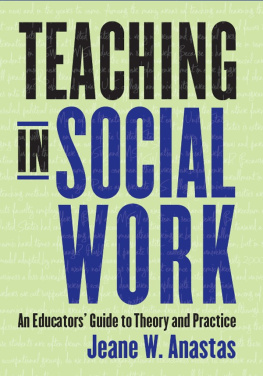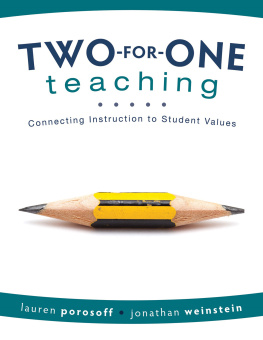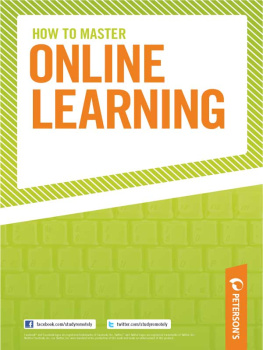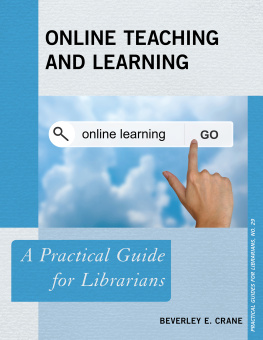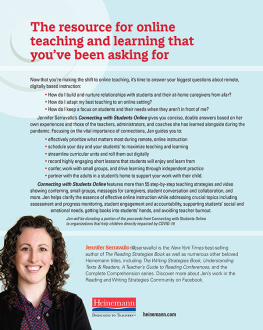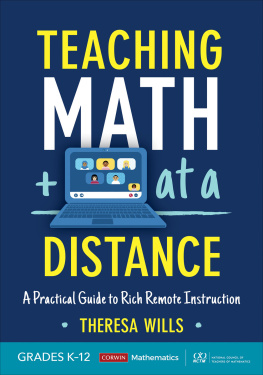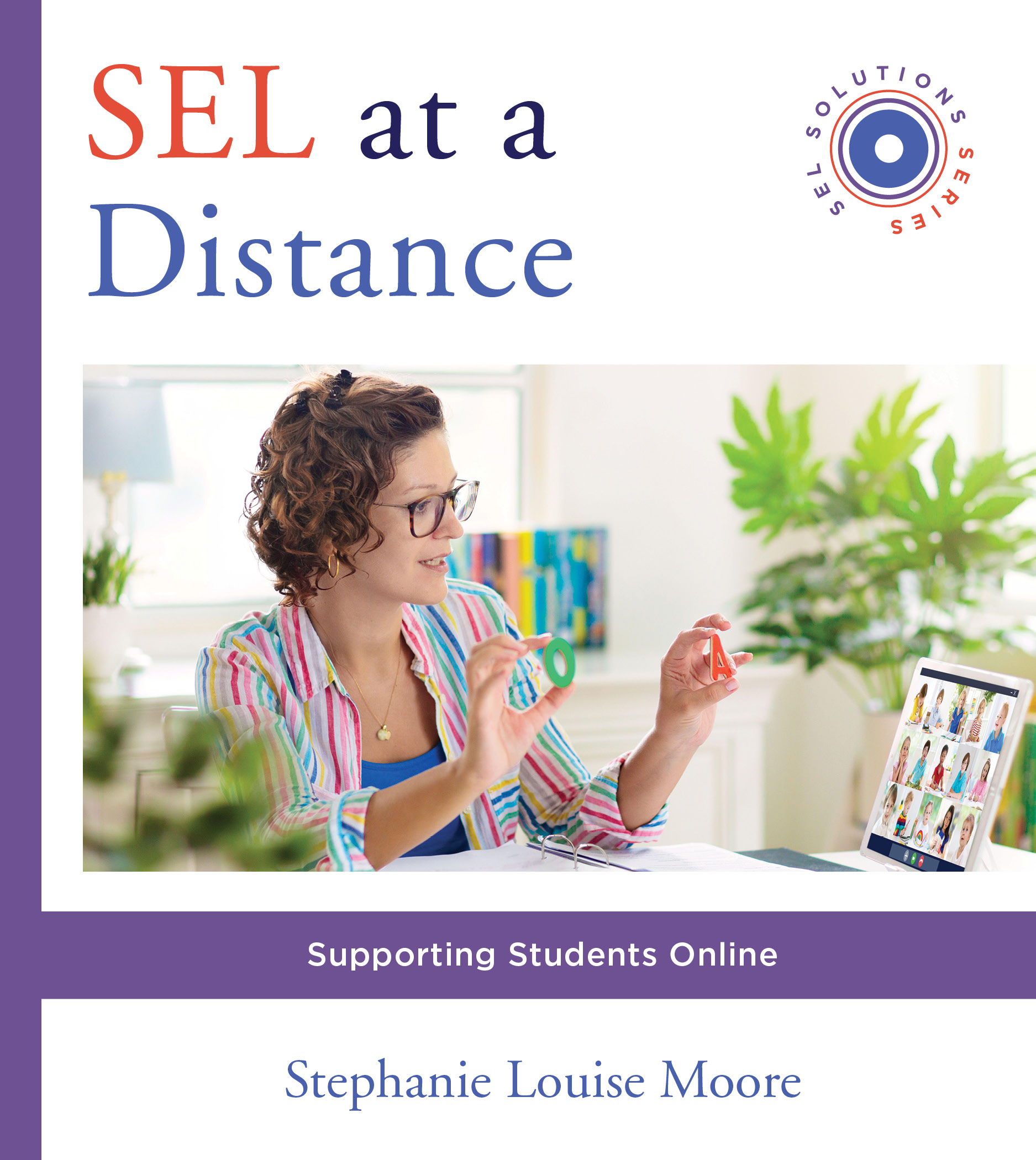Contents
Guide
Page List

T HE N ORTON S ERIES ON S OCIAL E MOTIONAL L EARNING S OLUTIONS P ATRICIA A. J ENNINGS , S ERIES E DITOR
SEL at a Distance
Stephanie L. Moore
SEL From the Start
Sara E. Rimm-Kaufmann
Preventing Bullying in Schools: A Social and Emotional Learning Approach to Early Intervention
Catherine P. Bradshaw and Tracy Evian Waasdorp
Mindfulness in the PreK5 Classroom: Helping Students Stress Less and Learn More
Patricia A. Jennings
Mindfulness in the Secondary Classroom: A Guide for Teaching Adolescents
Patricia C. Broderick
Assessing Students Social and Emotional Learning: A Guide to Meaningful Measurement
Clark McKown
SEL Every Day: Integrating Social and Emotional Learning with Instruction in Secondary Classrooms
Meena Srinivasan
NORTON BOOKS IN EDUCATION
SEL at a Distance
Supporting Students Online
STEPHANIE L. MOORE

A Norton Professional Book
This e-book contains some places that ask the reader to fill in questions or comments. Please keep pen and paper handy as you read this e-book so that you can complete the exercises within.
For Callie, Jamie, and Justinyou make my heart sing

Contents

The Norton Series on Social Emotional Learning Solutions (SEL Solutions Series for short) features compact books for educators focused on recommended SEL practices from experts in the field. Cutting edge research continues to confirm that teaching students social and emotional skills pays off in improved behavior and academic learning in school, and that those skills contribute to students later success in adulthood. These books are intended to provide school leaders and classroom teachers with SEL tools and strategies that are grounded in research yet highly accessible, so readers can confidently begin using them to transform school culture, improve student behavior, and foster deeper learning.
I am so pleased to introduce this new book by my friend and colleague Stephanie Moore entitled SEL at a Distance: Supporting Students Online. When I invited Stephanie to write a book on SEL and online learning, little did we know that education systems were going to be faced with the COVID-19 pandemic and that teachers would be frantically trying to figure out how to teach remotely. This book could not have come at a more critical time; distance and hybrid learning are here to stay. As educational institutions adapted to the pandemic, many realized the benefits of having distance or hybrid learning as an option for a variety of reasons. I believe that this book can become a lifeline for instructors at every level of our educational systems to learn how to teach well at a distance.
I first became familiar with Stephanies unique expertise in distance learning as a colleague at the University of Virginia, where she worked prior to taking her current position as a professor in the Organization, Information, and Learning Sciences program at the University of New Mexico. At the time she was tasked with supporting those of us who were building our now very successful online graduate programs, and I was working on the SEL emphasis for our Curriculum & Instruction M.Ed., Ed.S., and Ed.D. programs. As I considered how to develop the first course in the series, I was concerned about how to build a supportive learning community at a distance that embodied SEL principles. I recognized that to teach SEL to teachers, we instructors needed to model best practices ourselves. I had created online courses in the past, but they had always seemed two-dimensional and not very interactive. I thought, how can we create content and learning activities that are not only engaging, but that build the social and emotional competencies we are aiming to promote for teachers and students? Stephanie jumped at the chance to help me answer this question. Together we developed ways to make the learning active and engaging: the generative strategies she addresses in .
As the COVID-19 pandemic forced educators to learn how to teach online, it became evident that the physical separation of a remote environment was having a serious impact on everyones well-being. Educators and policy makers recognized that SEL was going to be more necessary than ever as we began to recover and schools tried to return to normal operations. This book addresses both of these concerns simultaneously. It provides guidelines for bridging not only the geographical but also the transactional (psychological and communication) distances in synchronous and asynchronous learning, while building the social and emotional competencies to be successful learners in this context.
SEL at a Distance begins with a clear explanation as to why SEL is critical for remote teaching and learning and how to apply the four recommended practices and SEL standards to a distance learning context. The book emphasizes the importance of understanding your individual learners, their ability to self-regulate in a distance learning context, and their access to technologies and family support. The book skillfully applies design principles to distance learning and how to recognize and work with affordances and constraints, bringing greater intentionality to the design process. Stephanie encourages us to focus less on content delivery and more on feedback, support, and interaction to make learning more student-centered. She addresses the importance of assessing and supporting students development of their self-regulation. This includes self-regulation of learning, motivation and emotions, behavior, learning environment, and interaction with others. She offers useful tips and strategies for building your teaching presence and a supportive learning community through a variety of types of interaction with students and opportunities for engagement. This includes giving students options for interaction such as creating break out rooms with different foci and using asynchronous discussion boards for reflection and processing. The text includes assessment strategies along with a variety of planning tools, making this book a comprehensive but succinct one-stop shop for learning and implementing the strategies needed to support students social and emotional growth while teaching remotely.
Patricia A. Jennings, M.Ed., Ph.D.
Editor, Norton Series on Social and Emotional Learning Solutions

Authors Note
One aspect of distance learning that you need to consider is the potential impact of particular learning management systems, other systems, and tools on your students privacy, at least if your school or district does not prescribe the use of particular systems and tools and you have to make your own choices about what methods to use.


